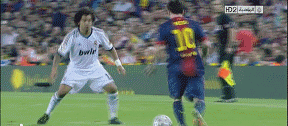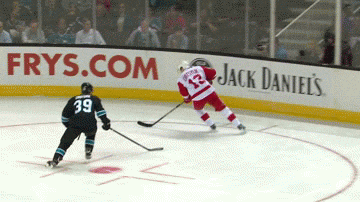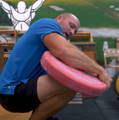How Do You Fix Tight Ankles?
A lot of athletes struggle with actual ankle mobility. We have to think about what ankle mobility leads to and what it means for sports performance. If our ankles are more mobile, meaning they have a greater range of motion and strength in that range of motion, we can accelerate faster sprinting, cut harder, squat deeper, and target our quads more with strength work (which in turn leads to better acceleration out on the field). This means that if we can improve the overall ankle mobility and stability, we can run faster, cut harder, be stronger with our squats, and improve various positions when receiving a snatch or clean.

All of these exercises can be used to improve specific aspects of sports performance.
When we are trying to improve ankle mobility we have to use the exercises in a strategic manner. We are always trying to improve ankle mobility, especially with athletes whose ankles get beat up. So right away, we are going to strategically use three movements right in a row.
1. Ankle Windshield Wipers
The first of these three movements involves going through dorsiflexion, rotate, plantar flexion, rotate, and do this over and over again for five reps to one side. We then repeat the movement going back the other way for the same amount of reps.




We want to go through this two or three times. This will light up the entire ankle and the feet. We want to remember to grab with our toes as we work and rotate.
2. Heel Walks With Knee Flexion
This movement is strictly based on dorsiflexion. Dorsiflexion is when the feet are pointed up and pulled toward the shin. We will walk with the ankle dorsiflexed. We will also have a bent knee as we walk forward and backward.

Try to be as stable as possible while walking. Some athletes may be pronated. Focus on driving the knee outs so the legs do not pronate. Do the two to three sets for ten reps forwards and backward. This leads us to the third exercise.
3. Sit On Calves With Pipe
This movement targets the posterior ankle. With athletes who have really tight calves or tight Achilles, this movement is great. Kneel down on the ground and put a foam roller on the Achilles/calves. From there, sit back on the foam roller and try to drive into the calves, pushing the foam roller into the heel.

We like to start athletes off using a foam roller. We will then get into using a slightly smaller pipe. We want to really DIG through to open up the Achilles. We will then progress into an even smaller pipe made of PVC. This movement will also make the quads more flexible.
This movement feels good in a really painful, sadistic way. Do this for two to three sets of five reps.
The key after finishing this movement is to right back into the ankle windshield wipers and dorsiflexion walks. Remember, these three movements are paired together.
These three movements are used to wake up and improve that mobility right away in the ankle joints.

4. Weighted Ankle Cranks
This next pairing we are going to reveal are two movements but we are going to share three to four different variations. We just want to stress that if the exercises in this blog are done two to three days a week, the ankle joints and knee joints will become more stable, create better range of motion, and more mobility in the ankles will lead to more mobility in the hips and lower back! More mobility in the ankles will also lead to less stress when catching a snatch. Everything starts from the ground up.
We have done this movement in the past with kettlebells. However, we like to use a barbell or even a plate. We want to sit deep in a squat with a plate on the knee. We want to press the plate and ankle forward to try to activate the ankle. We really want to try and feel this through the Achilles. Be active. Don’t just plop through. Feel where the body is tight. Do this for two to three sets of five reps to each side.

Now as the ankle gets stronger, feel free to use a heavier weight. A big key is trying to keep the heel down as much as possible.
One of the most prevalent things we see with young athletes is ankle pronation. It is where we see the ankles roll in. This is caused by tight ankles, flat feet, weak hamstrings, or weak groins.
This movement is a little bit more active because we want to think about pushing and grabbing more.
To do this movement that works on dorsiflexion and plantarflexion, we want to get a ball and focus on squeezing the ball in. Squeeze through the pinky toe all the way into the heels. Raise the heels up and down, controlling the eccentric position of the movement.
5. Heel Raises On Slant Board With Ball
This movement is a little bit more active because we want to think about pushing and grabbing more.
To do this movement that works on dorsiflexion and plantarflexion, we want to get a ball and focus on squeezing the ball in. Squeeze through the pinky toe all the way into the heels. Raise the heels up and down, controlling the eccentric position of the movement.

Do this for two to three sets of five to seven reps. One thing we can do is start to bend at the knee while performing the heel raises. This movement can be done on the edge of a platform or stair. Stacked plates can be used as well.
Making the knee flexion more prominent in the movement adds to the difficulty. Athletes who squat and tend to roll their ankles in, this is a movement that can force the heels in to help cure that unwanted rotation. This will lead to better ankle mobility and stability.

Recap
Greater ankle mobility leads to greater stability. Gaining a greater range of passive mobility as well as having stronger ankles is spectacular for athletic performance. We recommend doing these five movements three to five days as a warm-up or taking just one day to just target the ankles as an accessory plan.
Think about it. More mobile ankles with a greater range of motion will alleviate stress off the lower back, shoulders, and will also lead to being able to run faster because of having a steeper shin ankle allowing the body to accelerate faster. Give the movements a try and comment below with how it goes.
DANE MILLER
Dane Miller is the owner and founder of Garage Strength Sports Performance and Peak Strength Training System. He works with a coaches and athletes around the world building comprehensive programs for fitness and nutrition. Several times a year he leads a workshops for coaches, trainers, and fitness enthusiasts.
STRENGTH TRAINING
BUILT FOR YOU
Maximize your athletic potential with individualized, sport-specific training to increase your strength, explosiveness, and speed.
STRENGTH TRAINING
BUILT FOR YOU
Maximize your athletic potential with individualized, sport-specific training to increase your strength, explosiveness, and speed.


